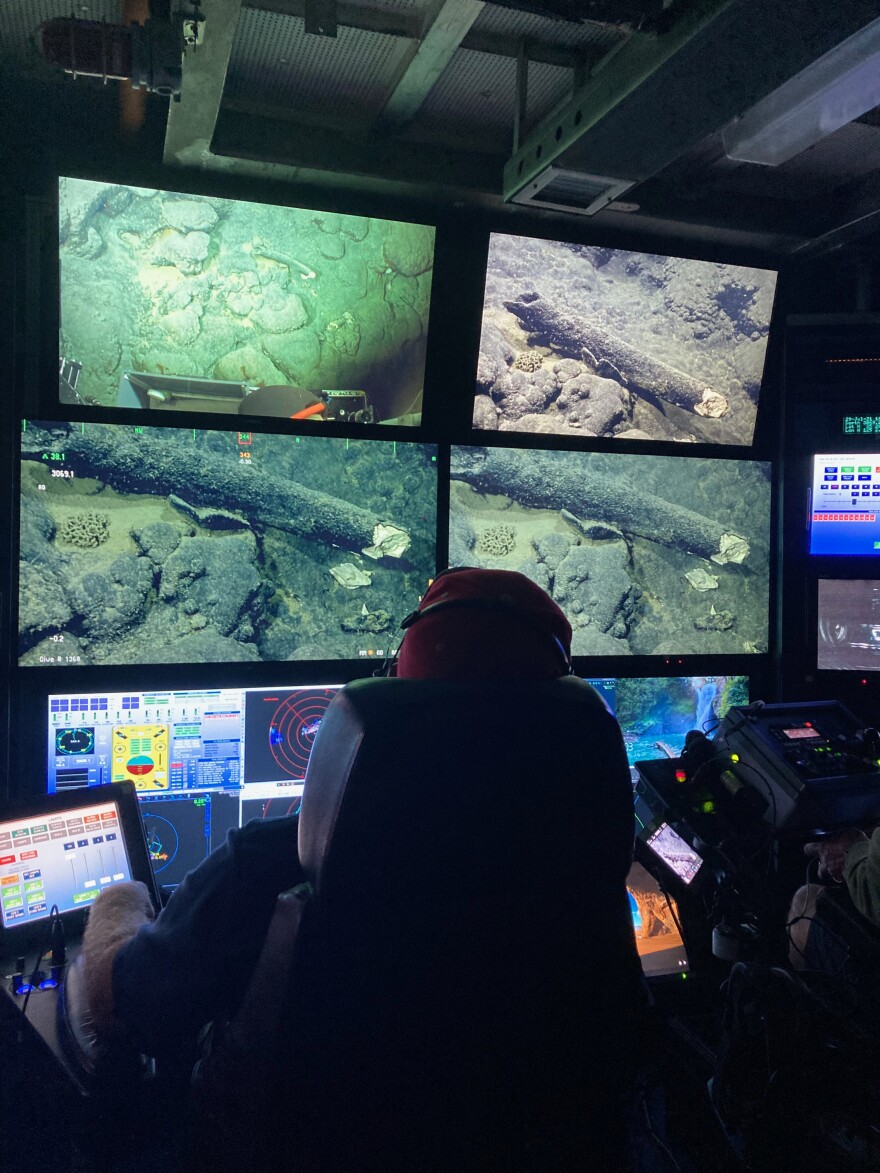Until they went extinct around 4,000 years ago, mammoths inhabited North America, including what is now the Central California coast. Fossils from these furry relatives of modern day elephants are often found by digging up layers of earth, but a surprising discovery might lead fossil hunters to search in an unexpected place: the deep ocean. Last summer, a team from the Monterey Bay Aquarium Research Institute recovered a fossilized mammoth tusk from the deep sea, 10,000 feet below the surface of Monterey Bay.
The tusk was spotted on a deep sea expedition in 2019 by an ROV pilot, who managed to snag a chunk of the crusty fossil. Scientists later confirmed it belonged to a young female mammoth from at least 200,000 years ago. Annie Roth, a science journalist based in Santa Cruz, joined the team on their trip to retrieve the rest of the tusk. Her reporting on the expedition appeared in the New York Times.
This conversation has been edited for length and clarity.
Jerimiah Oetting (JO): So to start off, could you tell us about the expedition?
Annie Roth (AR): I've been on a couple of expeditions in the Monterey Bay and scientists are always finding amazing things down there. But when I heard they found a mammoth tusk, I was pretty surprised. I've never heard of any sort of ancient specimen being found in the ocean, let alone right in my backyard. So I was all over this.
It took two days to get to where the tusk was originally found. They were stopping every once in a while and sending the ROV down. This expedition was one part allowing scientists to collect and study deep sea animals, and the other half was, "let's just also go scoop this tusk while we're out here."
JO: How did they end up actually recovering the fossil?
AR: When they went to go actually get it, it was super early in the morning. I go into this room filled with screens. The second it was even in the corner of the screen, we're all just like, "There it is! Oh my god, there it is!" And it was clear that it was a tusk. It was hard to miss.

JO: You saw the tusk in person. How would you describe it?
AR: It was heavy and it kind of smelled a little musty. It looks like those photos of a smoker's lungs they show you to scare you. The outside was covered in a thick layer of iron manganese crust, like everything is in certain parts of the deep sea. It was a little over three feet long, and it had sort of perfect characteristic shape — you can just picture it on an animal. The mammoth that this came from was a young female, and it was definitely one of the coolest things I've seen.
JO: One of the scientists you quote in the story, Dr. Katherine Moon, who is a postdoc at UC Santa Cruz, said it was an “Indiana Jones mixed with Jurassic Park moment.” Can you describe the feeling aboard the ship when the tusk was successfully recovered?
AR: So everyone was clapping and was so excited. There's marine biologists, there's engineers, there's paleontologists — all talking to each other about what they're most excited about once they get their hands on the tusk. Because they're looking for DNA, they're looking at the isotopes inside the tusk. They're wondering what Earth was like in the past. It's just such a cool collaboration of different kinds of scientists that are trying to get different kinds of information out of this tusk. So it's an ancient treasure, but it's also a scientific marvel.

JO: Why is this tusk special and how will it help advance science?
AR: So being 200,000 or 215,000 years old, it's from a time period known as the Lower Paleolithic, which scientists don't have a lot of specimens from. And it's very significant because it's a tusk. Tusks are special because they store more information than bones do. As mammoths and elephants grow, their tusks form these rings almost like a tree. And when you look at a specimen like this, you might be able to tell that the mammoths in California were starving, or they were eating really well; hey were having a lot of babies, or they were having no babies. This kind of information is important when you want to get a better sense of the life histories of the mammoths in this time period.
JO: So with that in mind, you mentioned in your piece there are some threats facing the deep ocean these days. Can you talk about that?
AR: The threats to the deep sea all involve big machinery going down there, disturbing the sediment destroying habitat. So right now, the biggest threats are deep-sea trawling and oil drilling. Those are existing, those are happening, and evidence shows that those are really disrupting deep-sea habitats.
But another threat that is looming is deep-sea mining. The deep sea is home to a lot of minerals like iron manganese and cobalt that are valuable and used in electronics. Companies are interested in going down there and collecting these minerals.
Everything in the deep sea is adapted to live in this extreme but very peaceful environment. If loud noises start happening all the time, if sediment is stirred up all the time, not only will the animals not be able to live the lives they're living, but specimens like this tusk will be impossible to find.
The deep sea is home to a lot of things we do not expect. We've only explored a tiny fraction of it. And if we keep looking, we might find a lot more stuff like this.
Annie Roth’s story is called “Why Was This Ancient Tusk 150 Miles From Land, 10,000 Feet Deep?” It was published in the New York Times last November.



